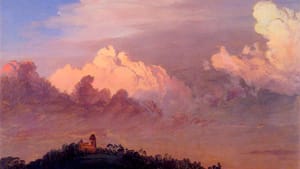Stay in the Loop
BSR publishes on a weekly schedule, with an email newsletter every Wednesday and Thursday morning. There’s no paywall, and subscribing is always free.
The art of landscape
Frederic Church's Olana

[American scenery] is a subject that to every American ought to be of surpassing interest; for, whether he beholds the Hudson mingling waters with the Atlantic, explores the central wilds of this vast continent, or stands on the margin of the distant Oregon, he is still in the midst of American scenery – it is his own land; its beauty, its magnificence, its sublimity – all are his; and how undeserving of such a birthright, if he can turn towards it an unobserving eye, an unaffected heart.
— Thomas Cole
Knowing I was leaving for a stay in the Hudson River Valley, one of the directors of the architecture-centered Athenaeum of Philadelphia urged me to visit Olana. As I found out, the historic site of Olana is considered the finest surviving artist’s studio-house in the nation.
Another friend gave me the newly published History of the Hudson River Valley: From Wilderness to the Civil War to read along the way. Therein I learned more than I had known of the first school of American painting, born in the 19th century in the Hudson River Valley. It was the era of Romanticism in art, and in culture, Manifest Destiny.
Appetite for nature
Within this appetite for nature and territorial expansion, a new kind of landscape painting arose from the brush of English-born immigrant Thomas Cole (1801-1848). Cole lived in Philadelphia in 1824, drawing at the Pennsylvania Academy of Fine Arts. By 1825, residing in New York City, he’d discovered, and was inspired to paint wilderness views of, the Catskill Mountains near the Hudson River. What distinguished his work, rendering it distinctively American, is that his landscapes were wild, not pastoral.
The artistic results of Cole’s forays into the Hudson Valley drew other artists to venture upriver from New York City. They found the beauty of the Hudson so compelling and the “divine architecture” of mountains and waterways so awesome that they considered the area a “sublime subject,” even a “special gift of God.” From their reverence, combined with incredible skill in realistic representation, came the large-scale oil paintings of the Hudson River School.
The paintings present nature as dominant and untamed. Waters feel powerful; mountains feel energetic, rising to the firmament of heaven; and forests feel ominous. If there are figures, they are unspecified persons humbled by the landscape.
Poetic light
While Cole inspired a host of followers, he took only one student, Frederic Edwin Church (1826-1900), beginning in 1844. A year later, Church ascended a 500-foot hill on the East side of the Hudson, directly across the river from his teacher’s domicile and 125 miles north of NYC, and began to sketch. It was for Church the start of a lucrative career as a celebrated landscape painter that took him around the world.
Church visited the tropics and painted Heart of the Andes (1859), with a pool that looks like you could dive into it, followed by Cotopaxi (1862), with an erupting volcano that looks like you could choke on it. He caught the dance of cascading water in perspectives of Niagara Falls. His depictions of nature, as far away as arctic icebergs, look real beyond conception; yet there’s something un-obvious about the work. The light within his skies is poetic, as if arriving from an intangible source.
Church’s magnum opus
 In 1860, Church bought land near the Hudson hill from whose height he’d first sketched the river below. In time he bought the hill, making it the ground for his house, where he lived through marriage and family until the end of his life. He called the Persia-inspired place Olana, his grandest work of art.
In 1860, Church bought land near the Hudson hill from whose height he’d first sketched the river below. In time he bought the hill, making it the ground for his house, where he lived through marriage and family until the end of his life. He called the Persia-inspired place Olana, his grandest work of art.
I visited Olana on the first day of spring with chilly air, bare trees, snow on the ground, and ice in the Hudson. The house or villa or monument is a marvel, a fantasy, an unlikely but pleasing blend of styles — Persian, Moorish, Italian, and then some. Church, as architect, used multicolored stone, brick, and tile to construct the house, with liberal and intricate stenciling outside and in.
The interior of Olana, decorated by Church and spouse Isabel, remains as exotic as it was during their residency, adorned with objects from an array of global cultures, including furniture of the Middle East, wood carvings from India, Chinese silks, and a noble Buddha from Japan seated in lotus posture within a niche of honor. The parlors are abundant with oil sketches (studies for larger works) by Cole, Church, and fellows.
Creating viewsheds
The placement of the house achieves perfection. As our tour guide pointed out, the farm view to the east is pastoral; the Hudson River view to the south is picturesque; the Catskill Mountain view to the west is sublime; and an amber mosaic window to the north, blocking outbuildings, is artful.
Church laid seven-plus miles of carriage road on the 250-acre property and installed a 10-acre lake. He planted thousands of trees and shrubs in planned patterns to create specific views, toward an overall composition he called a “viewshed.” Though arthritis inhibited Church’s ability to paint during his last 20 years, and though commissions ceased when the Hudson River School went out of fashion, Church derived artistic satisfaction from arranging scenery: “I have made about one and three-quarters miles of road this season, opening entirely new and beautiful views — I can make more and better landscapes in this way than by tampering with canvas and paint in the studio.”
Though arthritis inhibited Church’s ability to paint during his last 20 years, and though commissions ceased when the Hudson River School went out of fashion, Church derived artistic satisfaction from arranging scenery: “I have made about one and three-quarters miles of road this season, opening entirely new and beautiful views — I can make more and better landscapes in this way than by tampering with canvas and paint in the studio.”
The Hudson River School has returned to favor with the art world. Church’s landscapes, where the earth seems always to have been conceived in reference to the sky, are wondrous. But now that I’ve been to Olana, his most original contribution may be what he made of the actual land. The undisturbed views continue to display the scenery that is our birthright and, as Thomas Cole intimated, may affect our heart by turning toward it an observing eye.
Above right: Olana. Photo by Rolf Müller via Creative Commons/Wikipedia
Above left: Frederic Joseph Church, Plan of Olana, September 1886, watercolor on paper, OL. 1984.39. Collection Olana State Historic Site, NYS OPRHP
What, When, Where
Olana NY State Historic Site, 5720 State Route 9G, Hudson, NY. 518-828-0135 or www.olana.org.
Sign up for our newsletter
All of the week's new articles, all in one place. Sign up for the free weekly BSR newsletters, and don't miss a conversation.
 Joanna Rotté
Joanna Rotté